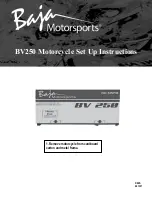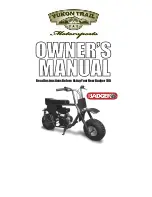
The Power Modes are the different engine maps the
rider can select to change power level and delivery to
suit his/her own riding style and surface conditions.
For the 959 Panigale there are three Power Modes,
one for each Riding Mode:
-
HIGH;
-
MED;
-
LOW.
Ride by Wire (RbW)
The Ride by Wire system is the electronic device that
controls throttle opening and closing. Since there is
no mechanical connection between the throttle
twistgrip and the throttle bodies, the ECU can adjust
power delivery by directly affecting throttle opening
angle.
The Ride by Wire system allows you to obtain
different power level and delivery according to the
selected Riding Mode (Power Mode), but even to
accurately control the engine brake (EBC), thereby
helping to control the rear wheel slipping (DTC).
Ducati Traction Control (DTC)
The Ducati Traction Control system (DTC) supervises
the rear wheel slipping control and settings vary
through eight different levels that are programmed to
offer a different tolerance level to rear wheel slipping.
Each Riding Mode features a pre-set intervention
level.
Level eight indicates system intervention whenever a
slight slipping is detected, while level one is for very
expert riders because it is less sensitive to slipping
and intervention is hence softer.
Anti-lock Braking System (ABS) 9M
ABS 9M system fitted to 959 Panigale is a two-
channel latest-generation system that actuates
combined braking with anti lift-up function for the rear
wheel so as to guarantee not only a reduced stopping
distance, but also a higher stability under braking.
ABS 9M system is specifically calibrated for sport
use, and features 3 different levels of intervention,
one per Riding Mode. In RACE mode the system only
works on the front discs to ensure top performance
for track use.
Ducati Quick Shift (DQS)
The Ducati Quick Shift (DQS) is the electronic shifter
control system used for racing purposes that allows
the rider to shift up under acceleration without using
27
Summary of Contents for Panigale 959 Corse 2018
Page 1: ......
Page 2: ...Owner s manual ENGLISH 1...
Page 26: ...1 4 3 8a 13 5 6 2 12 8a 11 10 9 7 6 Fig 3 25...
Page 32: ...Anti theft system 433 92 MHz 75 Khz 0 6 mA 31...
Page 37: ...8 9 5 6 3 15 2 10 12 11 14 1 4 7 13 Fig 6 36...
Page 54: ...Fig 17 53...
Page 68: ...Fig 22 67...
Page 72: ...Fig 23 71...
Page 102: ...2 4 1 2 2 2 1 1 1 2 1 2 1 2 1 1 2 1 2 2 1 2 1 2 1 Fig 47 101...
Page 105: ...4 1 2 2 1 2 1 2 1 2 2 2 2 2 1 1 1 1 1 Fig 49 104...
Page 108: ...4 1 2 4 2 1 2 4 4 2 1 Fig 51 107...
Page 110: ...4 1 2 4 2 1 2 4 4 2 1 Fig 52 109...
Page 112: ...4 1 2 4 2 4 4 2 1 2 1 Fig 53 111...
Page 114: ...4 1 2 4 2 1 2 4 4 2 1 Fig 54 113...
Page 116: ...4 1 2 4 2 4 4 2 1 2 2 1 1 Fig 55 115...
Page 123: ...4 1 2 4 4 2 1 2 1 2 1 Fig 60 122...
Page 125: ...4 4 Fig 61 124...
Page 128: ...4 1 2 4 2 1 4 4 4 Fig 62 127...
Page 131: ...4 1 2 4 2 1 4 4 4 Fig 64 130...
Page 134: ...4 1 2 4 4 1 2 4 4 Fig 66 133...
Page 141: ...4 1 2 4 4 4 2 1 1 1 2 1 2 2 Fig 72 140...
Page 144: ...4 1 2 4 4 2 1 1 2 1 2 1 2 1 2 Fig 73 143...
Page 147: ...4 1 2 2 4 1 2 1 2 1 Fig 74 146...
Page 151: ...4 1 2 2 1 1 1 2 1 2 1 2 2 Fig 77 150...
Page 153: ...Odometer Trip A Trip B and Trip Fuel km or miles 152...
Page 156: ...Instantaneous fuel consumption and Average fuel consumption 155...
Page 213: ...DU CATI DUCATI 4 6 7 7 5 2 2 3 3 1 8 Fig 125 212...
Page 268: ......
Page 269: ...Stampato 01 2018 Cod 913 7 380 1A...
Page 271: ...cod 913 7 380 1A...
















































